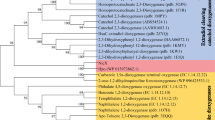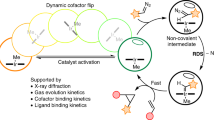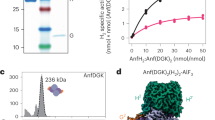Abstract
Chemical reactions inside single crystals are quite rare because crystallinity is difficult to retain owing to atomic rearrangements. Protein crystals in general have a high solvent content. This allows for some molecular flexibility, which makes it possible to trap reaction intermediates of enzymatic reactions without disrupting the crystal lattice. A similar approach has not yet been fully implemented in the field of inorganic chemistry. Here, we have combined model chemistry and protein X-ray crystallography to study the intramolecular aromatic dihydroxylation by an arene-containing protein-bound iron complex. The bound complex was able to activate dioxygen in the presence of a reductant, leading to the formation of catechol as the sole product. The structure determination of four of the catalytic cycle intermediates and the end product showed that the hydroxylation reaction implicates an iron peroxo, generated by reductive O2 activation, an intermediate already observed in iron monooxygenases. This strategy also provided unexpected mechanistic details such as the rearrangement of the iron coordination sphere on metal reduction.
This is a preview of subscription content, access via your institution
Access options
Subscribe to this journal
Receive 12 print issues and online access
$259.00 per year
only $21.58 per issue
Buy this article
- Purchase on Springer Link
- Instant access to full article PDF
Prices may be subject to local taxes which are calculated during checkout





Similar content being viewed by others
Change history
14 October 2010
In the version of this Article originally published online, an in-house error led to the omission of one of the beamlines from the Acknowledgements. This has now been corrected in all versions of the Article.
References
Costas, M., Mehn, M. P., Jensen, M. P. & Que, L. Dioxygen activation at mononuclear nonheme iron active sites: Enzymes, models, and intermediates. Chem. Rev. 104, 939–986 (2004).
Denisov, I. G., Makris, T. M., Sligar, S. G. & Schlichting, I. Structure and chemistry of cytochrome P450. Chem. Rev. 105, 2253–2277 (2005).
Kovaleva, E. G. & Lipscomb, J. D. Versatility of biological non-heme Fe(II) centers in oxygen activation reactions. Nature Chem. Biol. 4, 186–193 (2008).
Koehntop, K. D., Emerson, J. P. & Que, L. The 2-His-1-carboxylate facial triad: a versatile platform for dioxygen activation by mononuclear non-heme iron(II) enzymes. J. Biol. Inorg. Chem. 10, 87–93 (2005).
Que, L. The road to non-heme oxoferryls and beyond. Accounts Chem. Res. 40, 493–500 (2007).
Schlichting, I. et al. The catalytic pathway of cytochrome P450cam at atomic resolution. Science 287, 1615–1622 (2000).
Karlsson, A. et al. Crystal structure of naphthalene dioxygenase: Side-on binding of dioxygen to iron. Science 299, 1039–1042 (2003).
Kovaleva, E. G. & Lipscomb, J. D. Crystal structures of Fe2+ dioxygenase superoxo, alkylperoxo, and bound product intermediates. Science 316, 453–457 (2007).
Stavropoulos, P., Celenligil-Cetin, R. & Tapper, A. E. The Gif paradox. Accounts Chem. Res. 34, 745–752 (2001).
Walling, C., Partch, R. E. & Weil, T. Kinetics of decomposition of hydrogen-peroxide catalyzed by ferric ethylenediaminetetraacetate complex. Proc. Natl. Acad. Sci. USA 72, 140–142 (1975).
Udenfriend, S., Clark, C. T., Axelrod, J. & Brodie, B. B. Ascorbic acid in aromatic hydroxylation 1. A model system for aromatic hydroxylation. J. Biol. Chem. 208, 731–739 (1954).
Que, L. & Tolman, W. B. Biologically inspired oxidation catalysis. Nature 455, 333–340 (2008).
Thibon, A. et al. Proton- and reductant-assisted dioxygen activation by a nonheme iron(II) complex to form an oxoiron(IV) intermediate. Angew. Chem. Int. Ed. 47, 7064–7067 (2008).
Hong, S., Lee, Y. M., Shin, W., Fukuzumi, S. & Nam, W. Dioxygen activation by mononuclear nonheme iron(II) complexes generates iron-oxygen intermediates in the presence of an NADH analogue and proton. J. Am. Chem. Soc. 131, 13910–13911 (2009).
Punniyamurthy, T., Velusamy, S. & Iqbal, J. Recent advances in transition metal catalyzed oxidation of organic substrates with molecular oxygen. Chem. Rev. 105, 2329–2363 (2005).
Ménage, S. et al. O2 activation and aromatic hydroxylation performed by diiron complexes. J. Am. Chem. Soc. 120, 13370–13382 (1998).
Cherrier, M. V., Cavazza, C., Bochot, C., Lemaire, D. & Fontecilla-Camps, J. C. Structural characterization of a putative endogenous metal chelator in the periplasmic nickel transporter NikA. Biochemistry 47, 9937–9943 (2008).
Cherrier, M. V. et al. Crystallographic and spectroscopic evidence for high affinity binding of FeEDTA(H2O)(-) to the periplasmic nickel transporter NikA. J. Am. Chem. Soc. 127, 10075–10082 (2005).
Nam, W. Dioxygen activation by metalloenzymes and models. Accounts Chem. Res. 40, 465 (2007).
Pyrz, J. W., Roe, A. L., Stern, L. J. & Que, L. Model studies of iron tyrosinate proteins. J. Am. Chem. Soc. 107, 614–620 (1985).
Debruin, K. E., Naumann, K., Zon, G. & Mislow, K. Topological representation of stereochemistry of displacement reactions at phosphorus in phosphonium salts and cognate systems. J. Am. Chem. Soc. 91, 7031–7040 (1969).
Emerson, J. P., Farquhar, E. R. & Que, L. Structural ‘snapshots’ along reaction pathways of non-heme iron enzymes. Angew. Chem. Int. Ed. 46, 8553–8556 (2007).
Lehnert, N., Neese, F., Ho, R. Y. N., Que, L. & Solomon, E. I. Electronic structure and reactivity of low-spin Fe(III)-hydroperoxo complexes: Comparison to activated bleomycin. J. Am. Chem. Soc. 124, 10810–10822 (2002).
Solomon, E. I., Wong, S. D., Liu, L. V., Decker, A. & Chow, M. S. Peroxo and oxo intermediates in mononuclear nonheme iron enzymes and related active sites. Curr. Opin. Chem. Biol. 13, 99–113 (2009).
Katona, G. et al. Raman-assisted crystallography reveals end-on peroxide intermediates in a nonheme iron enzyme. Science 316, 449–453 (2007).
Neese, F. & Solomon, E. I. Detailed spectroscopic and theoretical studies on [Fe(EDTA)(O2)](3-): Electronic structure of the side-on ferric-peroxide bond and its relevance to reactivity. J. Am. Chem. Soc. 120, 12829–12848 (1998).
Horner, O. et al. Hydrogenperoxo-[(bztpen)Fe(OOH)](2+) and its deprotonation product peroxo-[(bztpen)Fe(O2)](+), studied by EPR and Mossbauer spectroscopy. Implications for the electronic structures of peroxo model complexes. Eur. J. Inorg. Chem. 3278–3283 (2002).
Larsen, S. K., Jenkins, B. G., Memon, N. G. & Lauffer, R. B. Structure affinity relationships in the binding of unsubstituted iron phenolate complexes to human serum-albumin—molecular-structure of iron(III) N,N'-bis(2-hydroxybenzyl)ethylenediamine-N,N'-diacetate. Inorg. Chem. 29, 1147–1152 (1990).
Bernadou, J. & Meunier, B. ‘Oxo-hydroxo tautomerism’ as useful mechanistic tool in oxygenation reactions catalysed by water-soluble metalloporphyrins. Chem. Commun. 2167–2173 (1998).
Park, M. J., Lee, J., Suh, Y., Kim, J. & Nam, W. Reactivities of mononuclear non-heme iron intermediates including evidence that iron(III)—hydroperoxo species is a sluggish oxidant. J. Am. Chem. Soc. 128, 2630–2634 (2006).
Seo, M. S. et al. Direct evidence for oxygen-atom exchange between nonheme oxoiron(IV) complexes and isotopically labeled water. Angew. Chem. Int. Ed. 43, 2417–2420 (2004).
Yoon, J. et al. Reactive intermediates in oxygenation reactions with mononuclear nonheme iron catalysts. Angew. Chem. Int. Ed. 48, 1257–1260 (2009).
Wackett, L. P., Kwart, L. D. & Gibson, D. T. Benzylic monooxygenation catalyzed by toluene dioxygenase from Pseudomonas putida. Biochemistry 27, 1360–1367 (1988).
Klein, G. W., Bhatia, K., Madhavan, V. & Schuler, R. H. Reaction of *OH with benzoic acid–isomer distribution in radical intermediates. J. Phys. Chem. 79, 1767–1774 (1975).
Janardanan, D. W. Y., Schyman, P., Que, L. Jr & Shaik, S. The fundamental role of exchange-enhanced reactivity in C–H activation by S=2 oxo iron(IV) complexes Angew. Chem. Int. Ed. 49, 3342–3345 (2010).
Almarsson, O. & Bruice, T. C. A homolytic mechanism of O–O bond scission prevails in the reactions of alkyl hydroperoxides with an octacationic tetraphrnylporphynato-iron(III) complex in aqueous solution. J. Am. Chem. Soc. 117, 4533–4544 (1995).
Bach, R. D. & Dmitrenko, O. The ‘somersault’ mechanism for the P-450 hydroxylation of hydrocarbons. The intervention of transient inverted metastable hydroperoxides. J. Am. Chem. Soc. 128, 1474–1488 (2006).
Bach, R. & Dmitrenko, O. Transient inverted metastable iron hydroperoxides in fenton chemistry. A nonenzymatic model for cytochrome P450 hydroxylation. J. Org. Chem. 75, 3705–3714 (2010).
Matsui, T., Unno, M. & Ikeda-Saito, M. Heme oxygenase reveals its strategy for catalyzing three successive oxygenation reactions. Accounts Chem. Res. 43, 240–247 (2010).
Bradford, M. M. Rapid and sensititve method for quantitation of microgram quantities of protein utilizing principle of protein-dye binding. Anal. Biochem. 72, 248–254 (1976).
Fish, W. W. Rapid colorimetric micromethod fot the quantitation of complexed iron in biological samples. Methods Enzymol. 158, 357–364 (1988).
Acknowledgements
We thank the Agence Nationale pour la Recherche for financial support (ANR 08-CP2D-12 and ANR NT05-2 41493). We also thank Colette Lebrun (SCIB, CEA-Grenoble) for ESI-MS measurements and the CEA, the University Joseph Fourier and the CNRS for institutional support. We thank the staff from the beamlines ID14, BM-30a, ID23-eh2 and cryobench ID29s of the European Synchrotron Radiation Facility in Grenoble, France.
Author information
Authors and Affiliations
Corresponding authors
Ethics declarations
Competing interests
The authors declare no competing financial interests.
Supplementary information
Rights and permissions
About this article
Cite this article
Cavazza, C., Bochot, C., Rousselot-Pailley, P. et al. Crystallographic snapshots of the reaction of aromatic C–H with O2 catalysed by a protein-bound iron complex. Nature Chem 2, 1069–1076 (2010). https://doi.org/10.1038/nchem.841
Received:
Accepted:
Published:
Issue Date:
DOI: https://doi.org/10.1038/nchem.841
This article is cited by
-
An efficient, step-economical strategy for the design of functional metalloproteins
Nature Chemistry (2019)
-
Design of artificial metalloproteins/metalloenzymes by tuning noncovalent interactions
JBIC Journal of Biological Inorganic Chemistry (2018)
-
Observation of gold sub-nanocluster nucleation within a crystalline protein cage
Nature Communications (2017)
-
The structure of the periplasmic nickel-binding protein NikA provides insights for artificial metalloenzyme design
JBIC Journal of Biological Inorganic Chemistry (2012)
-
Synthesis and structure of binuclear iron(ii) complex with the cage-like ligand as a model of methane monooxygenase
Russian Chemical Bulletin (2011)



